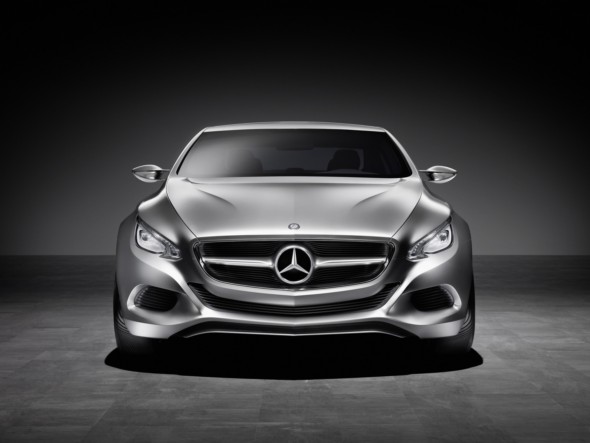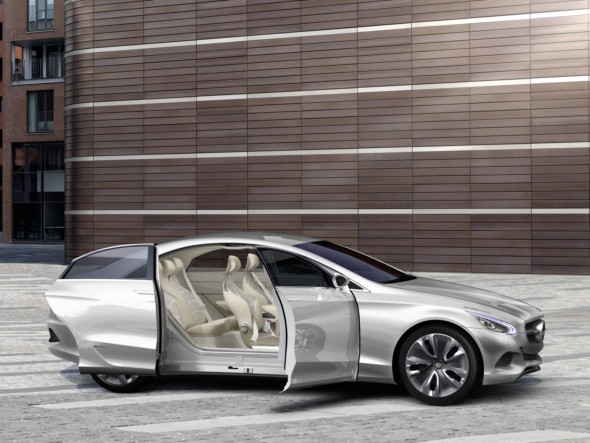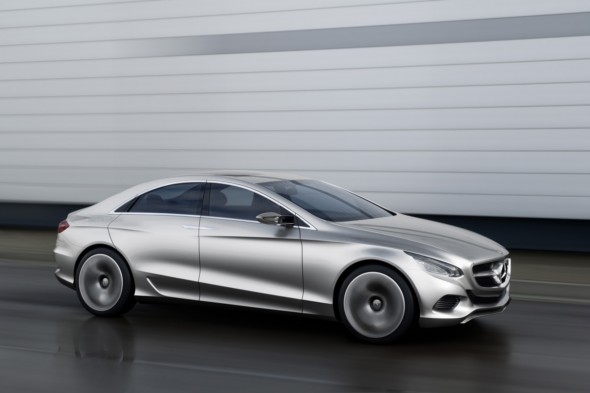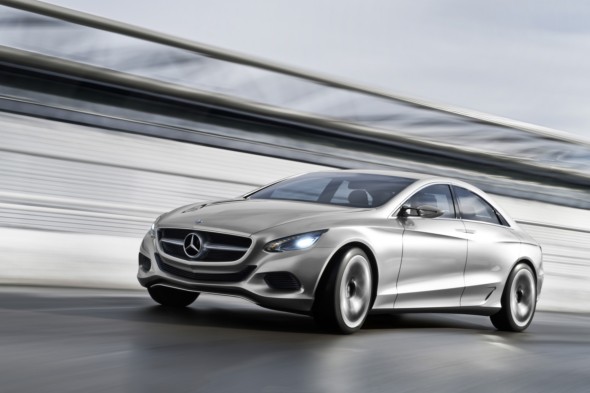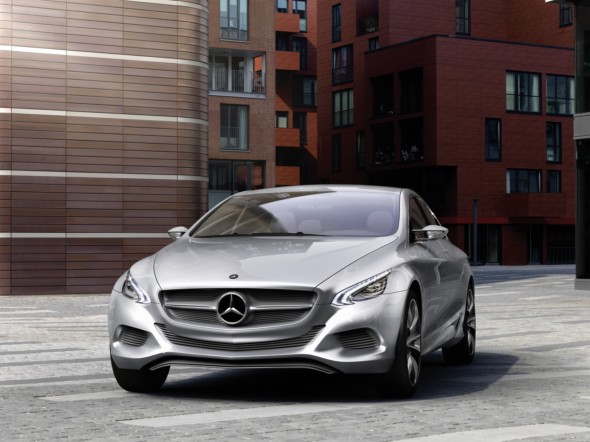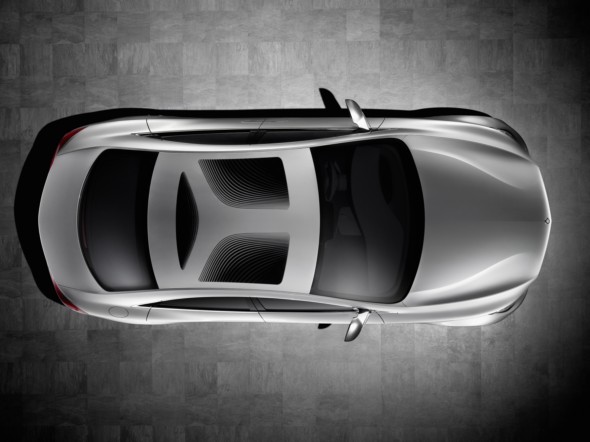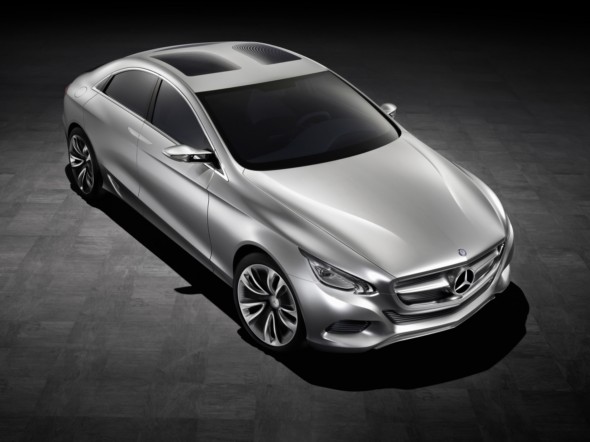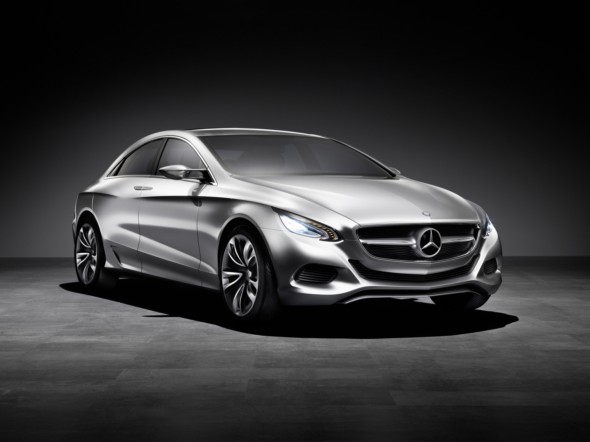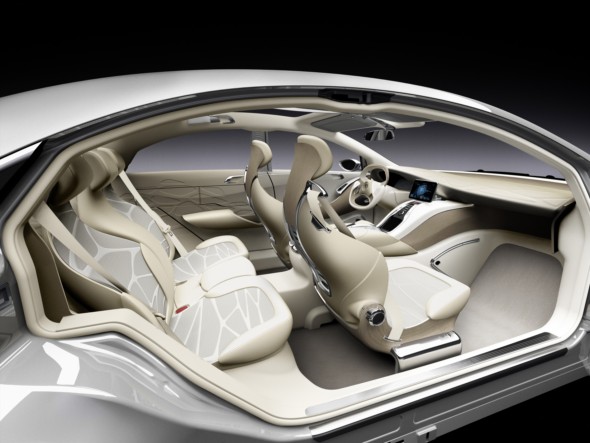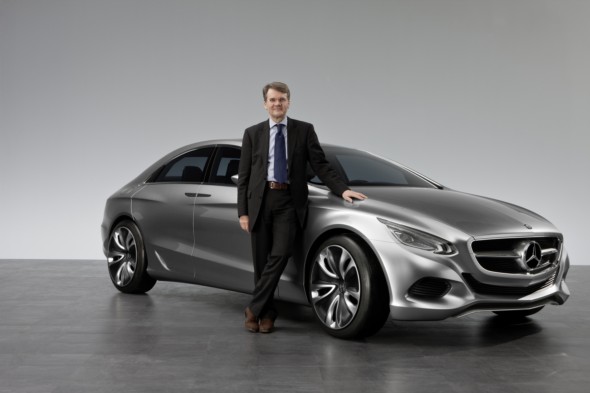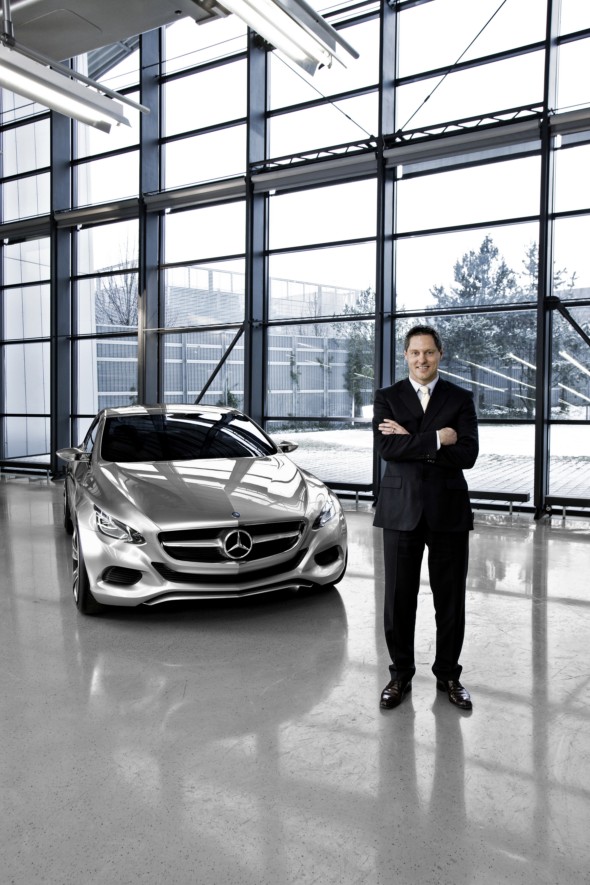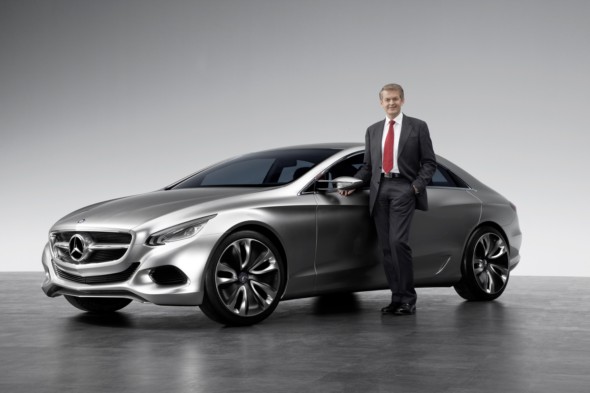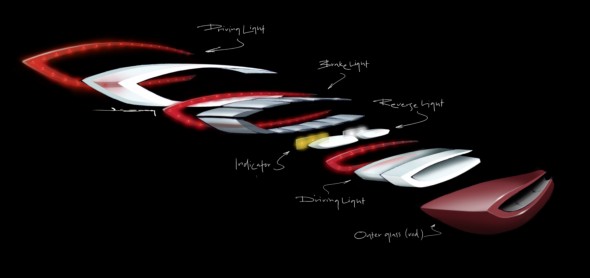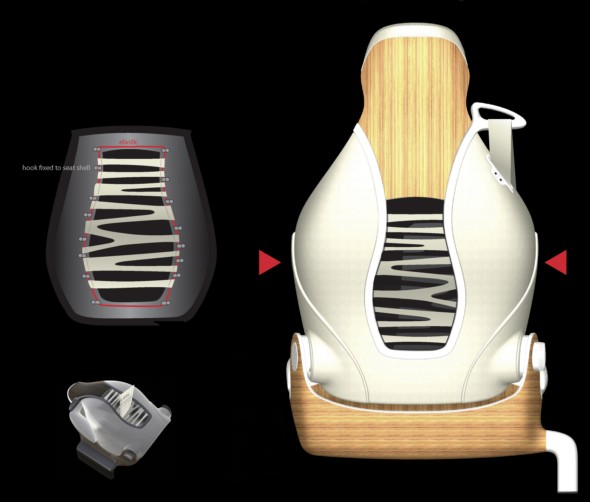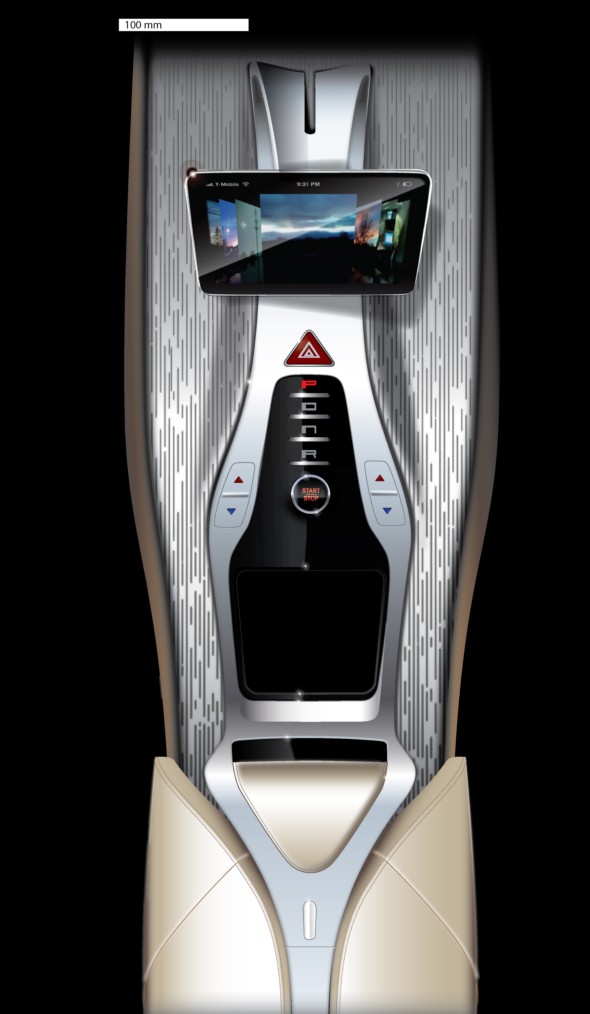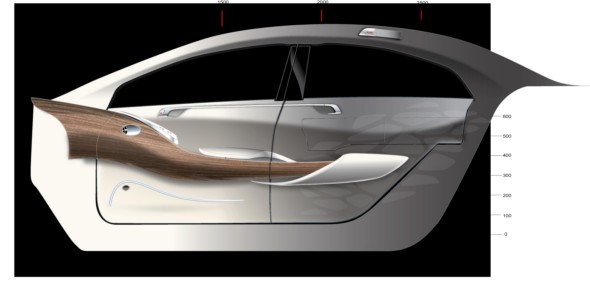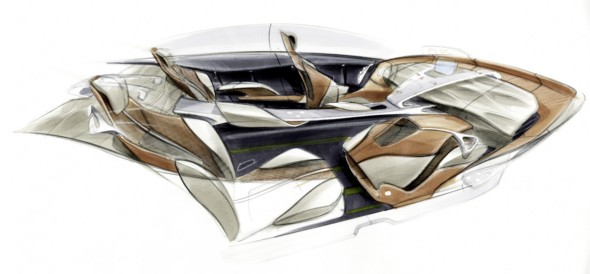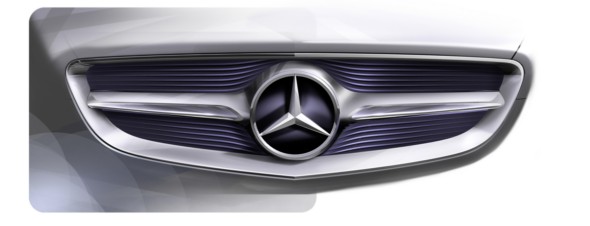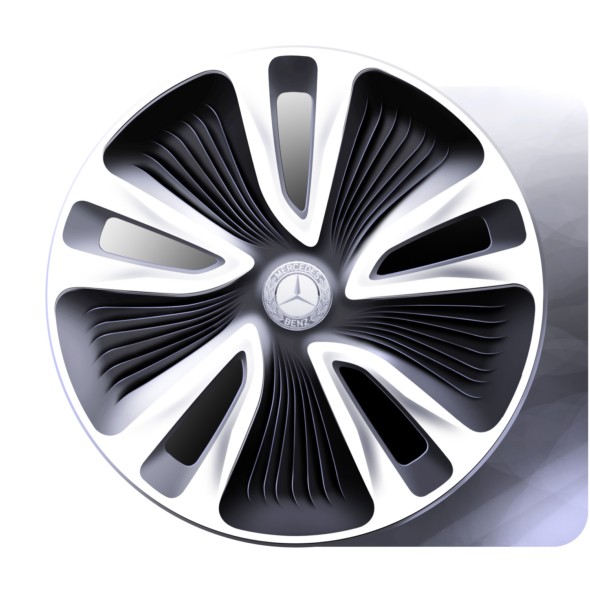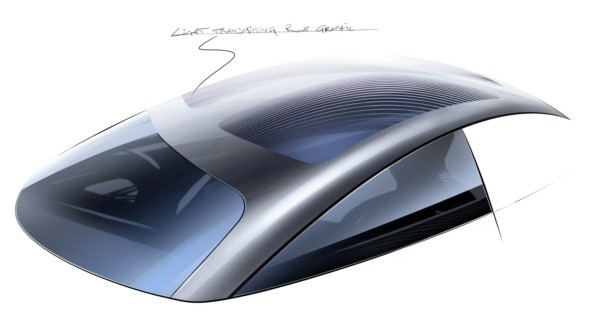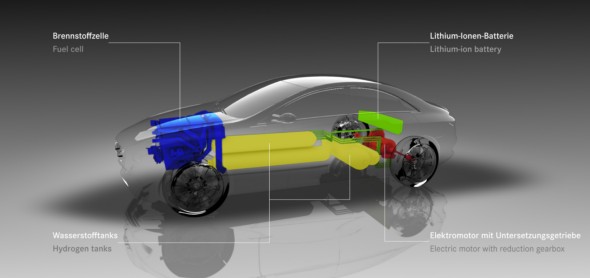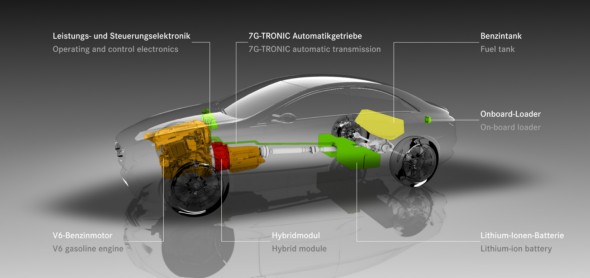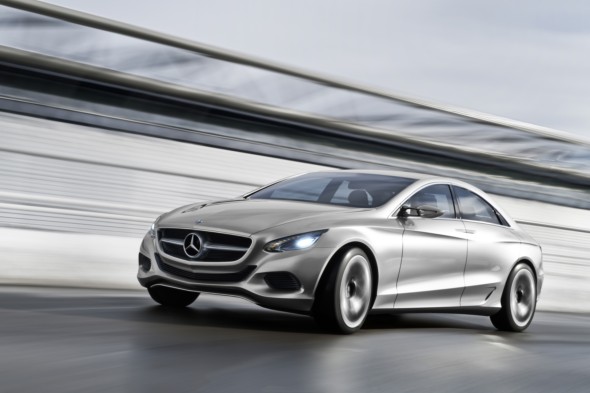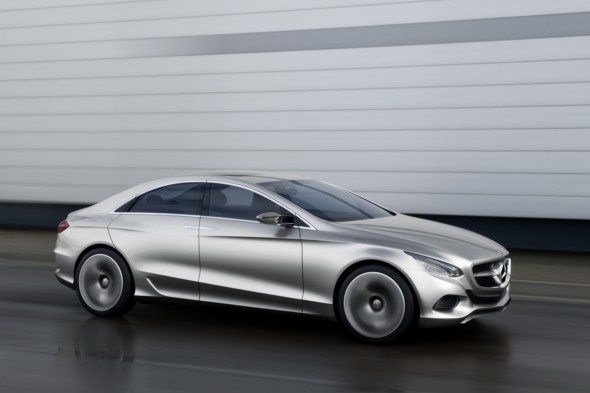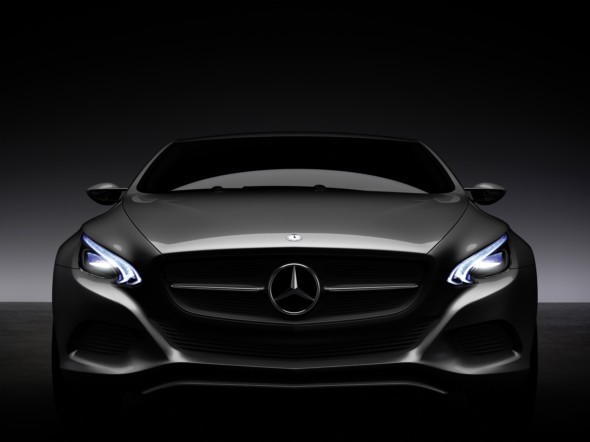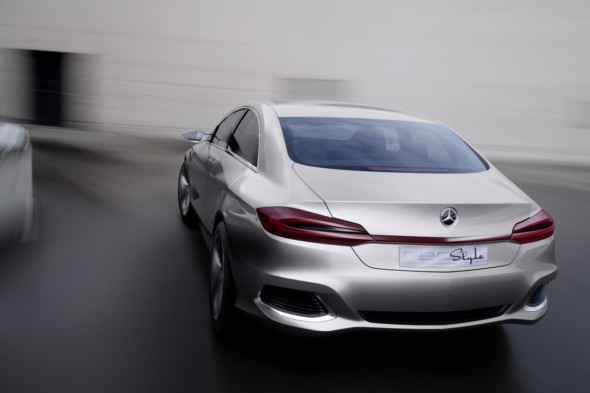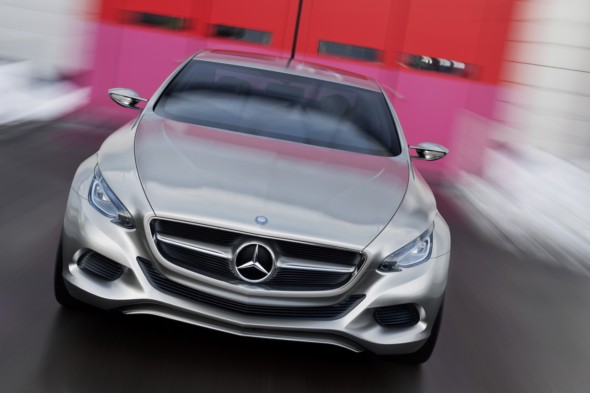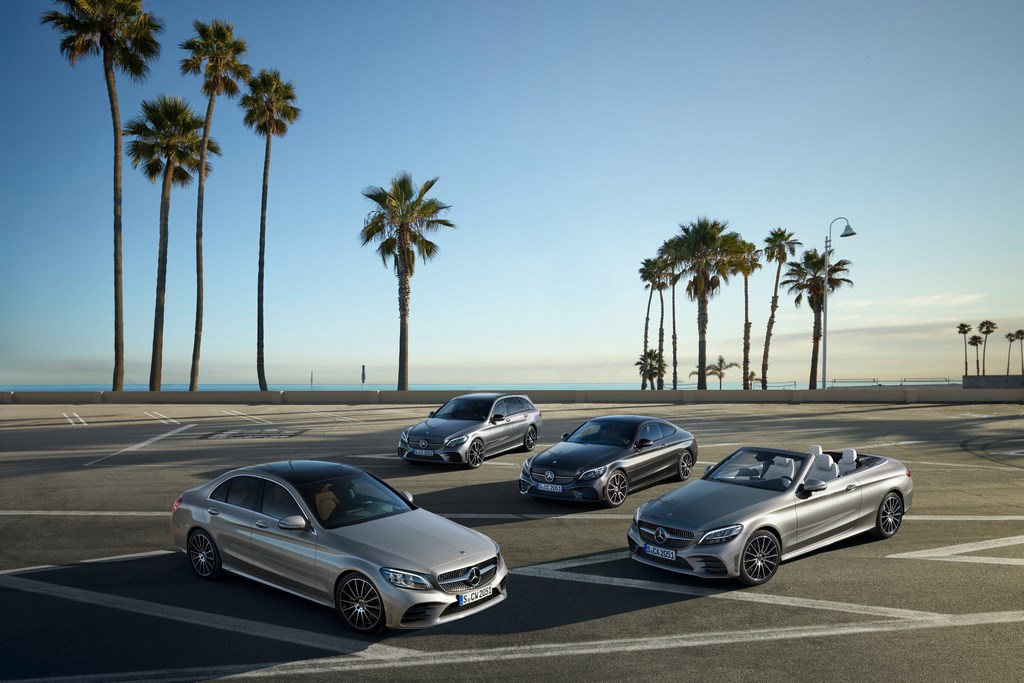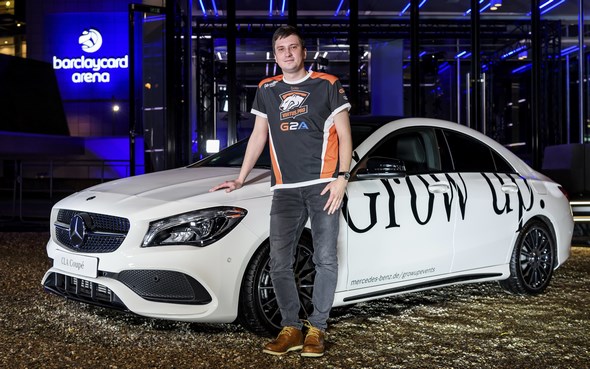Mercedes-Benz F 800 Style
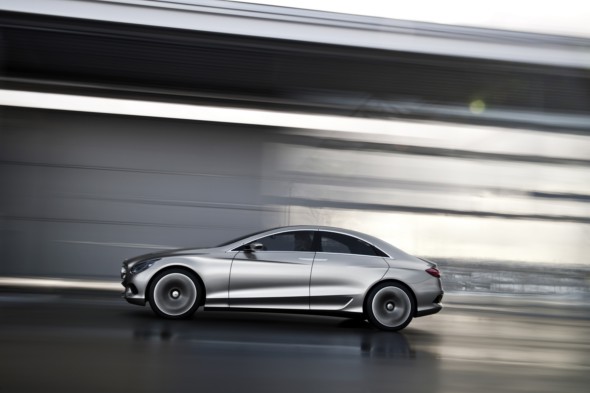
Efficiency paired with elegance: Pioneering upper-range sedan with “green” technology and avant-garde design
- A reinterpretation of the concept of “fascination and responsibility”
- Multi drive platform enables use of two alternative drive systems — either Plug-in Hybrid or fuel cell
- Intelligent display concept focusing on “electric driving”
- HMI with cam touchpad for intuitive and precise operation
- Traffic Jam Assistant for increased comfort and safety
Mercedes-Benz’ F 800 Style research vehicle is showing the future of premium automobiles from a new perspective, as the five-seat upper-range sedan combines highly efficient drive technologies with unparalleled safety and convenience features and an emotive design idiom, which interprets current Mercedes-Benz styling in line with the brand’s hallmark attribute of cultivated sportiness. The F 800 Style has a spacious interior full of intelligent seating, operating, and display concepts.
Another unparalleled feature for a large sedan worldwide is an all-new multi drive platform, which is suited for electric drives with fuel cells (enabling ranges of almost 600 kilometers) as well as the use of Plug-in Hybrids that can drive for up to 30 kilometers solely on electricity. Both variants of the F 800 Style therefore make locally emission-free mobility possible at the level of a premium-class automobile, while at the same time being fully suited for everyday driving and providing a dynamic driving experience.
“We are dedicated to reconciling our responsibility for the environment with practical customer utility in a fascinating automobile,” says Dr. Thomas Weber, the Daimler Board of Management member responsible for Group Research and Mercedes-Benz Cars Development. “The new F 800 Style research vehicle combines this commitment to providing the leading innovative drive concepts with our traditional Mercedes strengths in the areas of design, safety, comfort, and outstanding performance.”
A glance into the future of pioneering upper-range sedans
Within the 4.75-meter external length of the F 800 Style, all of the components of the vehicle’s especially efficient and environmentally compatible alternative drives (Plug-in Hybrid or fuel cell drive system) are installed in a space-saving manner in the engine compartment and the gaps within the chassis.
Each of the drive systems takes up comparatively little space for the installation. This applies in particular to the electric drive with fuel cell, which has been enhanced by Mercedes-Benz to be compact and powerful. The front end’s compact package was made possible through the consistent downsizing of all F-CELL components. As a result, the entire interior space is preserved and offers lots of room for five occupants.
“For many decades now, our research vehicles have been turning pioneering concepts into reality and thereby setting future trends. We set a course on the large touring sedan segment in 2007, when we presented the F 700,” says Prof. Herbert Kohler, Head of E-Drive & Future Mobility and Chief Environmental Officer at Daimler. “Characteristic features of the F 800 Style are its innovations, whose development is already close to the series production stage. This is true not only of the electric drive with fuel cells but also of the Plug-in Hybrid, whose components were taken from our modular system for electric and hybrid vehicles.”
F 800 Style with Plug-in Hybrid: Outstanding performance despite emissions of only 68 grams CO2 per kilometer
In combination with the very powerful Plug-in Hybrid drive system, the F 800 Style is a very dynamic expression of the concept of “fascination and responsibility.” Its drive unit consists of a V6 gasoline engine with an output of approximately 220 kW (300 hp) with next-generation direct injection and a hybrid module with an output of about 80 kW (109 hp) so that it delivers a total power of around 300 kW (409 hp). The lithium-ion battery with a storage capacity of >10 kWh can be recharged either at a charging station or a household power socket.
Thanks to its powerful and high-torque hybrid module, in the city the F 800 Style can run exclusively on electricity and therefore without generating any local emissions. Because it also has a high torque right from the moment it starts, the vehicle has the same driving performance as a car with a V6 gasoline engine even when operating in electric mode. The F 800 Style with the Plug-in Hybrid can run purely on electricity for up to 30 kilometers.
The F 800 Style research vehicle therefore marks a further important step in the creation of a market-ready Plug-in Hybrid. Mercedes-Benz will begin series production of the S 500 Plug-in Hybrid with the introduction of the next-generation S-Class.
Due to its efficient drive system and a CO2 bonus for the battery-electric driving mode, the vehicle has a certified fuel consumption of only 2.9 liters of gasoline per 100 kilometers. This corresponds to extremely low CO2 emissions of only 68 grams per kilometer. However, thanks to its outstanding efficiency, the F 800 Style equipped with a Plug-in Hybrid nevertheless has a driving performance comparable to a sports car (0-100 km/h in 4.8 s, top speed of 250 km/h). When in electric mode, the F 800 Style has a top speed of 120 km/h, and can thus also meet the needs associated with long-distance driving.
As is the case with the Mercedes-Benz S 400 HYBRID introduced in the summer of 2009 and the Vision S 500 Plug-in Hybrid, the especially powerful electric module (approx. 80 kW) of the F 800 Style is completely integrated into the housing of the 7G-TRONIC seven-speed transmission. The lithium-ion battery in the new research vehicle is located underneath the rear seat, where it takes up little space, creates a low center of gravity, and ensures maximum safety in the event of a crash.
The electric drive components in the F 800 Style with the Plug-in Hybrid once again demonstrate the versatility of Mercedes-Benz’ extensively scalable modular hybrid system. The hybrid system can be expanded in various ways, depending on performance needs and the area of application. On this basis, it is possible to combine hybrid modules and batteries of different performance ratings with fuel-efficient, high-torque gasoline and diesel engines.
Examples range from the current mild hybrids all the way to Plug-in Hybrids that enable exclusively electric driving over long distances. In developing the F 800 Style with Plug-in Hybrid, the Mercedes engineers particularly focused on improving the possibilities of driving exclusively with electricity in urban traffic. Thanks to high power reserves, the F 800 Style in e-mode easily masters all kinds of city traffic while producing no local emissions.
With the new hybrid module, the top speed of the F 800 Style with Plug-in Hybrid has been increased to 120 km/h in electric mode compared to the Vision S 500 Plug-in Hybrid. At the same time, it emits only 68 grams of CO2 per kilometer, compared to the latter vehicle’s 74 grams per kilometer.
Flexible, secure, and fully suited to everyday use: The F 800 Style with electric drive and fuel cell technology
The F 800 Style also offers clean driving pleasure in the variant equipped with an electric drive based on fuel cell technology. The vehicle’s electric motor develops around 100 kW (136 hp) as well as a strong torque of approximately 290 Nm. The fuel cell generates the traction current by chemically reacting hydrogen with oxygen onboard the vehicle, producing water vapor in the process as the only emission.
The components of the fuel cell drive are taken from the range of e-drive modules, which Mercedes-Benz developed for a variety of different electric vehicles. These components, which are already being installed in the limited edition B-Class F-CELL, can be flexibly used and are suited for a variety of different drive configurations. The F 800 Style is an example of this, as it uses rear-wheel drive, in contrast to the B-Class F-CELL. The same components are also installed in commercial vehicles, with developments here being spearheaded by the new Citaro fuel cell bus, which is equipped with two of the F-CELL systems used in passenger cars.
The new Mercedes-Benz research vehicle has the fuel cell located in the front, while the compact electric motor is installed near the rear axle. The lithium-ion battery is located behind the rear seats and is protected as well as possible against the effects of accidents, as are the four hydrogen tanks. Two of the tanks are located in the transmission tunnel between the passengers, while the other two are underneath the rear seat.
F 800 Style with further innovations for more comfort and safety
In addition to a multi drive platform that is unparalleled for large sedans and the combination of different alternative drive technologies, the F 800 Style features many other technological innovations, such as a new operating and display concept and a human-machine interface (HMI) with a cam touchpad. The display shows many additional functions not found in conventional instrument clusters. The F 800 Style’s operation and display concept focuses for the first time primarily on electric driving functions.
HMI with cam touchpad for intuitive and precise operation
The new cam touchpad HMI is an intelligent system expansion for COMAND. For many years now, Mercedes-Benz has been forging ahead with the development of innovative operating and display systems. A particularly user-friendly innovation is being presented in the F 800 Style.
The HMI unit here consists of a touchpad on the center console and a camera that records video images of the user’s hand as it works the pad. The live image of the hand is presented in transparent form in the central display above the console. The user sees the contours of his or her fingers glide across the image without covering anything, thus ensuring that all of the functions of the currently used menu remain visible so that they can be easily operated by applying slight pressure to the touchpad. Pressing the display with one’s fingers generates a feeling similar to that of touching laptop keys so that users know when they are carrying out specific actions.
The cam touchpad HMI unit recognizes finger movements on the pad surface such as wiping, pushing, turning, and zooming, thus enabling intuitive regulation of the climate control system, telephone, stereo and navigation systems, and Internet access. The unit enhances active safety as well, because it is extremely easy and convenient to use and therefore does not distract the motorist as much from the actual task of driving. And unlike conventional touchscreens, the HMI cam touchpad does not get smudged with fingerprints.
Conventional touchpad units generally depict hand or finger positions only by a small point in the display. Their lack of precision makes it very risky to enter information while driving, because doing so diverts the motorist’s attention too much from the road. By contrast, the HMI with cam touchpad can be easily and safely operated even while driving. Test persons have confirmed that the HMI with cam touchpad is extremely easy and safe to use, particularly as a result of the transparent depiction of the hand.
Range on Map: Graphic range depiction during electric operation
Another very user-friendly innovation created by the Mercedes engineers is the Range on Map function, which shows the remaining possible travel radius during electric vehicle operation as a 360° depiction on a map. Should municipalities only permit purely electric automobile traffic in the future, the driver can determine whether the electric range of his or her vehicle is sufficient for the journey into and out of the urban area by means of the Range on Map function. The system provides this function by combining information on the current battery charge level with data from the navigation system.
In the new operating and display concept, Mercedes-Benz has created a solution that provides an unparalleled amount of information in a system of exemplary clarity. The engineers have thus achieved the goal of successfully developing a comprehensive yet easy-to-operate information and control system for future automobiles equipped with electric or partially electric drive systems. A further-developed version of the system can be set up to also display recharging stations.
Mirror display is easy on the eyes
The mirror display of the innovative cam touchpad HMI eliminates the differences between close proximity visibility and visibility over longer distances, thus contributing to the driver’s physiological safety in a manner typical of Mercedes. The system displays driving and vehicle information via a mirror in the instrument cluster so that they appear to be farther away. The distance the eye looks into is thus extended, which means less switching between near and far focus — and therefore less fatigue — for the eyes.
New DISTRONIC PLUS Traffic Jam Assistant further reduces the stress of driving
Back in 2006, Mercedes-Benz introduced DISTRONIC PLUS, the world’s first proximity and speed control system that operates even when the car is standing still. The system substantially reduces the stress for drivers in dense traffic, as it regulates the distance from the vehicle in front even at very low speeds all the way down to a standstill.
With its new DISTRONIC PLUS Traffic Jam Assistant feature in the F 800 Style, Mercedes-Benz has also become the world’s first automaker to implement a system that is also capable of automatically following the vehicle in front of it into curves. The system recognizes the difference between driving along curving roads and turning, which means it does not “blindly” follow the vehicle up in front — for example, when it changes lanes in order to exit the highway.
The result is that at speeds of up to about 40 km/h, the Traffic Jam Assistant function takes care of both longitudinal and transverse movements so that drivers do not have to steer themselves. The driver can just sit back and relax — with hands on the steering wheel. When the 40 km/h mark is exceeded, the steering torque that keeps the vehicle in its lane is gradually reduced to a point at which the Traffic Jam Assistant smoothly disengages. Drivers can, of course, override the system at any time. Sensitive sensors notice active steering movements, thus automatically deactivating the system’s lateral control function.
“The DISTRONIC PLUS Traffic Jam Assistant is the logical continuation of the Mercedes-Benz assistance and safety philosophy. With it, we are setting another milestone on the path toward creating innovative systems, with which we will further enhance the high driving comfort that is a hallmark of Mercedes,” says Prof. Bharat Balasubramanian, Head of Product Innovations & Process Technologies at Group Research and Advanced Engineering.
The required data is generated by radar distance sensors that are supplemented by a stereo camera.
PRE-SAFE 360° improves safety in rear-end collisions
While the Traffic Jam Assistant heightens comfort and active safety, the innovative protective system known as PRE-SAFE 360° further improves passive safety. PRE-SAFE 360° is based on the proactive occupant protection system PRE‑SAFE® developed by Mercedes-Benz. Unlike the previous system, PRE-SAFE 360° also monitors the area behind the vehicle. As a result, the system engages the brakes around 600 milliseconds before an anticipated rear-end collision occurs.
The key advantage of this system is that braking a stationary vehicle that is hit in the rear helps prevent secondary accidents such as those that occur when the car is catapulted uncontrolled into an intersection or a pedestrian crossing. It goes without saying that PRE-SAFE 360° also allows the driver to take control at any time. For example, the brake is immediately released if the driver hits the gas pedal knowing that there is sufficient space in front of his or her own vehicle to avoid the rear impact.
Rear pivot-and-slide doors ensure maximum entry comfort
A particularly customer-friendly innovation of the F 800 Style is its rear doors. Whereas the front doors are attached to the A-pillar in a conventional manner and open wide toward the front, the rear doors slide backward when opened, as they are suspended from an interior swivel arm. Because the doors slide back close to the vehicle body, occupants find it much easier to get into and out of the automobile in tight parking spaces.
The F 800 Style also has no B-pillar, making the entire space between the A and C-pillars completely accessible when the doors are opened. Despite the lack of a B-pillar, the F 800 Style boasts a bodyshell that is both extremely robust and lightweight, and that meets the stringent demands for crash safety that are a hallmark of the Mercedes brand.
Reinterpretation of the typical Mercedes-Benz design idiom
The F 800 Style is both a technology package and a showcar. This research vehicle was created through close cooperation between technical research and advanced engineering departments and the advanced design studios in Sindelfingen, Germany and Como, Italy. Its exterior appearance is marked by a long wheelbase, short body overhangs, and a sensually flowing roof line.
“The exciting coupe-like roof line, and in general the vehicle’s balanced proportions, lend it a stylish sporty look that reinterprets the Mercedes-Benz design idiom and emphasizes the sculptural character of the F 800 Style,” says Mercedes-Benz Head of Design Prof. Gorden Wagener. “The result is a harmonious blend of innovative form and function, which conveys a sense of great styling and authority.”
Front end with distinctive LED headlights
The vehicle’s front end features a variation of the radiator grille with the centrally placed brand star that is typical of Mercedes sports cars. The curved radiator grille bars softly flow around the tube holding the Mercedes-Benz brand star. Along with the wide radiator grille and the generously curved air intake openings, the model’s unique bright LED headlights emphasize the dynamic nature of the research vehicle.
The headlights are divided into individual segments for daytime running lights, turn signal indicators, and primary headlights. The F 800 Style’s taillights are also equipped with state-of-the-art LED units that enable an exciting interplay of indirect illumination and direct beams. The result is an attractive, unmistakable, and memorable visual effect.
Wood and light create a cozy interior
Precious wood surfaces and lots of light ensure a high level of comfort in the interior of the F 800 Style. Occupants will immediately notice the modern sense of lightness, and functional elements such as the driver area and the door armrests seem to float in space like sculptures. The innovative lightweight-construction seats in the F 800 Style consist of a magnesium shell and a carbon fiber laminate seatback across which a fine yet resistant netting is stretched.
The seat shell also features genuine wood veneer. For the wood veneer process, Mercedes-Benz engineers used a 3D surface coating procedure designed especially for the veneering of three-dimensional surfaces. This same procedure was used to create the wood finishing in the center console, on the doors, and in the driver area. These wood finishing pieces are molded as 3D laminated components and are augmented by an aluminum core, which ensures that the components meet the high crash safety standards that are a hallmark of Mercedes.
Successful transfer from research to series production
Mercedes-Benz has presented 13 research vehicles since the early 1980s. The range of fascinating and pioneering automobiles that was unveiled — beginning with Auto 2000 in 1981 and leading up to today’s F 800 Style — offers proof of the consistency and foresight with which Mercedes-Benz engineers address the core issues of research and technology in order to develop innovative solutions for the future.
Many systems that were first used in research vehicles and viewed as revolutionary at the time can now be found in Mercedes-Benz production cars, including the DISTRONIC proximity-controlled cruise control, which was first installed in the F 100 in 1991 and made its series production debut in the S-Class in 1998.
The F 800 Style is continuing this approach. Like its predecessors, the model features key drive, comfort, and safety system innovations, as well as an avant-garde design, all of which point the way forward for the series production of future Mercedes-Benz vehicles that will continue to impressively combine fascination and responsibility.
Technical data of the Mercedes-Benz F 800 Style with Plug-in Hybrid
Key data and driving performance values:
F 800 Style with Plug-in Hybrid | Gasoline hybrid drive |
| Length (mm) | 4,738 |
| Width (mm) | 1,938 |
| Height (mm) | 1,445 |
| Wheelbase (mm) | 2,924 |
| Trunk capacity (l) | 440 |
| Inertia class (kg) | 1,700 |
| Tires | 215/45R20 |
| Displacement (l) | 3.5 |
| Rated output of gasoline engine (kW/hp) | Approx. 220/300 |
| Rated output of electric motor (kW/hp) | Approx. 80/109 |
| Total output (kW/hp) | Approx. 300/409 |
| Acceleration 0–100 km/h (sec) | 4.8 |
| Maximum speed (km/h) | 250* |
| Electric maximum speed (km/h) | 120* |
| Fuel economy (liters/100 km) | 2.9** |
| Electric range (km) | 30 |
| Total range (km) | Approx. 700 |
| CO2 emissions (g/km) | 68 |
| Emissions rating | EU 6 |
| Energy content of lithium-ion battery (kWh) | >10 |
*Electronically limited **NEDC overall consumption, preliminary figures
Technical data of the Mercedes-Benz F 800 Style with F-CELL
Key data and driving performance values:
F 800 Style with F-CELL | Fuel cell drive |
| Length (mm) | 4,738 |
| Width (mm) | 1,938 |
| Height (mm) | 1,445 |
| Wheelbase (mm) | 2,924 |
| Trunk capacity (l) | 440 |
| Inertia class (kg) | 1,700 |
| Tires | 215/45R20 |
| Rated output (kW/hp) | Approx. 100/136 |
| Rated torque (Nm) | Approx. 290 |
| Acceleration 0–100 km/h (sec) | 11 |
| Maximum speed (km/h) | 180* |
| Hydrogen consumption (kg/100 km) | 0.9** |
| Total CO2 (g/km min–max) | 0 |
| Range (km) NEDC | Approx. 600 |
| Energy content of lithium-ion battery (kWh) Battery (kWh/kW) | 1.4 |
*Electronically limited **NEDC overall consumption, corresponds to 3.0 liters of diesel equivalent
The design of the F 800 Style
Innovative in form and function: A look at the upper-range sedan of tomorrow
- Stylish-sporty interpretation of the new Mercedes-Benz design
- LED headlights provide an exciting, distinctive detail
- Spacious interior despite compact outer dimensions
- Modern sense of lightness on the inside
A synthesis of green technology and stylish-sporty design, the F 800 Style impressively demonstrates Mercedes-Benz’ ability to harmonize automobile fascination and emotion with the continually increasing demands of environmental compatibility. Like its predecessor, the F 700 presented at the 2007 IAA motor show, the latest research vehicle from the brand with the star offers a clear idea of what we can expect in the future from premium automobiles “made by Mercedes-Benz.” Whereas the 5.18-meter F 700 provided a preview of the large touring sedan of the future, the much shorter F 800 Style (4.75 meters exterior length) points the way toward developments to come in the upper-range sedan segment.
“The F 800 Style combines the functionality of a groundbreaking upper-class sedan with the highly emotional formal idiom of the new Mercedes-Benz design,” says Mercedes-Benz Head of Design Gorden Wagener. “The long wheelbase and the model’s intelligent interior design ensure a generous amount of space and great freedom of movement for five occupants. The result is a distinctive harmony of form and function, whereby the Mercedes brand value of ‘cultivated sportiness’ can be seen and felt in every detail.”
With a total length of 4.75 meters, the F 800 Style has both a longer wheelbase (2,924 millimeters) and a greater width (1,938 millimeters) than today’s upper-range sedans. All of the components of the vehicle’s extremely efficient and environmentally compatible alternative drive system (either Plug-in Hybrid or fuel cell drive) are installed in a space-saving manner in the engine compartment and in the gaps within the chassis. As a result, the entire interior space is preserved and offers plenty of room for up to five occupants.
Reinterpretation of the typical Mercedes-Benz design idiom
The exterior appearance of the F 800 Style is marked by its long wheelbase, short body overhangs, and a sensually flowing, coupe-like roof line. The dynamic side view and the vehicle’s balanced proportions lend it a sporty yet sensual look that conveys a feeling of style and superior performance. “The F 800 blends seamlessly into our design scheme,” says Wagener. “It’s immediately recognizable as a Mercedes, even though it embodies our reinterpretation and further development of the brand’s typical design idiom.”
Another important design feature in the F 800 Style is its organically stretched body surface elements. These flow into convex transition zones and are delineated by precisely curved lines. This creates characteristic lines which visually subdivide the vehicle body and generate emotional tension. The powerful front contoured line on the sidewall extends across the flank and then fades off as it moves downward. This line lends the F 800 Style — with its grey metallic ALU-BEAM color tone — a highly dynamic appearance, without making it seem aggressive. The sensually curved roof line underscores the exceptional aerodynamic quality of the coupe, which has a height of 1.43 meters.
The Mercedes-Benz brand star is smoothly framed
The F 800 Style’s front end features a variation of the radiator grille with the centrally placed brand star that can be found in the new E-Class coupe as well as in other models. This grille extends prominently toward the front in the F 800 Style, while the bionically curving lamellae softly flow around the tube holding the Mercedes-Benz brand star. Other noticeable design features include the drop-shaped and thus aerodynamically designed exterior mirrors, whose housings, like those in the Concept BlueZERO model, are partially transparent and backlit.
LED headlights give the F 800 Style an expressive “face”
A “shining” example of technological and design innovation at Mercedes-Benz is offered in the truest sense of the word by the powerful LED headlights in the F 800 Style. The combination of fiber optics and state-of-the-art LED technology lends the vehicle a striking appearance. Along with the wide radiator grille and the generously curved air intake openings, the LED headlights emphasize the dynamic nature of the research vehicle. The headlights are divided into individual segments for daytime running lights, turn signal indicators, and primary headlights.
The F 800 Style’s taillights are also equipped with state-of-the-art LED units that enable an exciting interplay of indirect illumination and direct beams, which further enhances the stylish appearance of the vehicle’s rear section at night. The result is an attractive, unmistakable, and memorable visual effect.
Translucent roof makes for a bright interior
The F 800 Style’s translucent roof is divided into several segments. With flowing lines that dissolve and let more and more light through, the roof incorporates the wave styling elements of the air outlets. The F 800 Style’s 20-inch alloy wheels are equipped with plastic inserts whose bionically arranged air intake openings are shaped like filigree turbine blades.
Wood and a pleasant color gradient create a cozy interior
Natural wood surfaces and a harmonious color gradient from light to dark make for an elegant and cozy interior in the F 800 Style. This interior was created at the Mercedes-Benz Advanced Design Studio in Como, Italy, and its modern sense of lightness is immediately noticed by occupants. Functional elements such as the driver area and the door armrests seem to float in space like sculptures, while light-colored wood surfaces underscore the model’s elegant ambience. Side panels covered with alcantara form a visual contrast to the wood. The panels are light beige in the area of the A-pillar and grow darker in a smooth color gradient as they extend to the back, ending in a dark grey tone in the rear of the vehicle. Additional design details are provided by attractive engraved patterns in the rear door panels.
Innovative real wood veneering process for seats, door armrests, and the driver area
The innovative lightweight-construction seats in the F 800 Style consist of a magnesium shell and a carbon fiber laminate seatback across which a fine yet resistant netting is stretched. The seat shell is veneered with real wood. For the wood inlaying process, Mercedes-Benz engineers employed an innovative technology designed especially for the veneering of three-dimensional surfaces. The new 3D surface coating procedure developed by Mercedes-Benz was also used to install the wood finishing in the center console, on the doors, and in the driver area. These wood finishing pieces are molded as 3D laminated components and are augmented by an aluminum layer, a feature that significantly improves crash safety.
The single-section organically curved cockpit offers plenty of legroom for front-seat passengers. In a setup similar to the one used in the F 700 research vehicle from 2007, all important information for the driver is presented on the large and clearly arranged display unit in the instrument cluster. A key new feature of this improved display is that it focuses for the first time on data associated with electric vehicle operation. The unit thus puts important relevant information such as the battery charge state and remaining vehicle range at the center of attention.
The integrated display unit, which elegantly protrudes from the curved console, provides for a feeling of exceptional interior spaciousness. Outstanding ergonomic quality is guaranteed by the new HMI with cam touchpad integrated into the center console. The unit also boasts several technical innovations, including its ability to visually depict the current functions within the cam touchpad’s menu structure on the display above the center console.
Rear pivot-and-slide doors blend into the elegant design lines
The rear doors of the F 800 Style ideally embody the harmony of form and function that typifies the vehicle. Whereas the front doors are attached to the A-pillar in a conventional manner and open toward the front, the rear doors slide backward when opened. The innovative swivel arm construction of the rear doors allowed designers to forgo the use of visible door rails, giving the F 800 Style the appearance of being cast in one piece when its doors are closed. “We integrated the door technology into the vehicle in such a manner that it blends seamlessly into the overall design flow, thus perfectly harmonizing ergonomics and design,” says Wagener.
Form and function are equally important
The F 800 Style is both a technology package and a showcar. The latest Mercedes-Benz research vehicle was created through close international cooperation between the technical research and advanced engineering departments and the advanced design studios in Sindelfingen and Como, Italy. Form and function are equally important in the F 800 Style. For example, all of the air intake openings and outlets have an important technical function in addition to the bold design statement they make, and the organic, nature-based wave shape for the protective grille is a typical design feature that is present throughout the vehicle.
The technology of the F 800 Style
Cultivated sportiness with Plug-in Hybrid or fuel cell electric drive
- Plug-in Hybrid or fuel-cell electric drive with superior driving performance and zero local emissions
- Flexible multi drive platform with optimized crash characteristics
- New display concept focusing on electric drives
- HMI with cam touchpad for intuitive and precise operation
- Even greater active safety and convenience: DISTRONIC PLUS with
new Traffic Jam Assistant - Even greater passive safety: PRE-SAFE 360°
In the future, it will be more important than ever to bring mobility and environmental protection into harmony. The world’s population will continue to grow, in particular in the metropolitan areas. This will result in an increased demand for mobility and consequently increased traffic density. According to the latest studies, the total number of automobiles in the world will double to roughly 1.8 billion vehicles by 2030. As the inventor of the automobile, Mercedes-Benz has also assumed responsibility for its continued development — with respect to efficient and clean drive solutions without compromising comfort, safety, functionality, and driving fun.
The research and development work of the Mercedes engineers is by no means restricted to current customer wishes and legal requirements, however. Long-term trends — in the technology domain as well as on the social and cultural level — are identified scientifically and adapted specifically for the development of automobiles. Systematic and goal-oriented futurology is thus an essential foundation of the innovative power of Mercedes-Benz, which takes on concrete form in research vehicles emblazoned with the star.
Mercedes-Benz brings pioneering concepts to life in its research vehicles, which is why it has continually set trends for the future in recent decades. The latest example is the F 800 Style. It features numerous technical innovations that are already at a near-series or even series-ready stage of development. Examples of this include the drive system options based on either Plug-in Hybrid or fuel cell technology.
Multi drive system platform for two different drive concepts
The F 800 Style is suitable for use with a variety of drive system options thanks to its flexible multi drive platform, as the following example with two technically independent variants demonstrates:
- As the Plug-in Hybrid, the F 800 Style offers electric mobility with zero local emissions in urban settings. Over longer distances, a gasoline engine equipped with the latest-generation direct-injection technology is supported by the hybrid module, thereby enabling a high-performance and efficient driving experience
- The F-CELL variant is equipped with a fuel cell unit that runs on hydrogen for electric driving with zero local emissions. The only emission from electric cars powered by a fuel cell is water vapor
According to Dr. Thomas Weber, member of the Board of Management of Daimler AG with responsibility for Group Research and Mercedes-Benz Cars Development, “Hybrid and fuel cell electric drives are two important elements of our broad drive system portfolio, which enables us to satisfy all of the requirements of our customers throughout the world for the mobility of today, tomorrow, and beyond. Our road to sustainable mobility is a three-lane highway. The spectrum encompasses the optimization of vehicles with advanced combustion engines, further gains in efficiency through tailored hybridization, and driving with zero local emissions through the use of fuel cell or battery-powered vehicles.”
F 800 Style with Plug-in Hybrid: A three-liter car disguised as a sports car
Mercedes-Benz is setting new standards for future sustainable mobility with the F 800 Style. Thanks to a powerful and high-torque hybrid module, the F 800 Style Plug-in Hybrid can run almost exclusively on electricity in the city and therefore without generating any local emissions. Because it has a high torque right from the moment it starts, the vehicle has the same driving performance as a car with a V6 gasoline engine when operating in electric mode. It has an electric range of 30 kilometers. The efficient drive system and a CO2 bonus for the battery-electric driving mode help the F 800 with Plug-in Hybrid to a certified fuel consumption of only 2.9 liters of gasoline per 100 kilometers. This corresponds to extremely low CO2 emissions of only 68 grams per kilometer. Thanks to its outstanding efficiency, the F 800 Style equipped with a Plug-in Hybrid nevertheless performs like a powerful sports car. The car accelerates from zero to 100 km/h in only 4.8 seconds, and its top speed is electronically limited to 250 km/h. “The F 800 Style is thus the first three-liter car to feature such sporty performance while at the same time offering room for five passengers,” says Dr. Weber. Its drive unit consists of a V6 gasoline engine with an output of approximately 220 kW (300 hp) with next-generation direct injection and a hybrid module with an output of about 80 kW (109 hp) so that it delivers a total power of around 300 kW (409 hp). The lithium-ion battery with a storage capacity of >10 kWh can be recharged either at a charging station or a household power socket.
The powerful electric drive enables the F 800 Style to drive at speeds of up to 120 km/h solely on electric power. The low-noise electric drive, which produces zero local emissions, thus covers the entire urban transportation spectrum and a large portion of the interurban spectrum. The vehicle has a cruising range of up to 30 kilometers in electric mode. Extreme efficiency is also a characteristic of the new 3.5 liter gasoline engine. The V6 engine features innovative spray-guided gasoline direct injection with high-precision piezo injectors. Thanks to the drive unit’s high efficiency, the 45 liter fuel tank in the F 800 Style Plug-in Hybrid is sufficient for a high combined range of around 700 kilometers.
Versatile modular hybrid system
The electric drive components in the F 800 Style with the Plug-in Hybrid once again demonstrate the versatility of Mercedes-Benz’ intelligent, extensively scalable modular hybrid system. The hybrid system can be expanded in various ways, depending on performance needs and the area of application. For example, hybrid modules of various performance classes and batteries delivering the associated capacities can be combined with the most frequently produced gasoline and diesel engines from Mercedes. All hybrid modules are compatible with the 7G-TRONIC automatic transmission.
All variants of the hybrid drive system can be realized on the basis of these components: from mild hybrids to hybrids that also enable all-electric driving in addition to the boost, start/stop and recuperation functions. Another option is the Plug-in Hybrid used in the F 800 Style, which had previously been presented in similar form at the IAA 2009 in the Vision S 500 Plug-in Hybrid. With this particularly high-performance version of the Mercedes hybrid drive system, the battery can be charged via a household outlet, thus increasing the model’s electric range.
From a design standpoint, the hybrid module with around 80 kW output in the F 800 Style differs only slightly from the 44 kW variant used in the Vision S 500 Plug-in Hybrid. Whereas the lithium-ion battery in the Vision S 500 Plug-in Hybrid was placed behind the rear seats, the electric storage unit is now located under the rear seat in the F 800 Style. This installation location ensures the greatest possible crash safety, good driving dynamics thanks to the vehicle’s low center of gravity, and unrestricted space in the interior of the vehicle. The 45 liter gasoline tank is mounted behind the rear seat backrests, again in the interest of crash safety and to save space. The result is a generous 440 liters of trunk space. In designing the F 800 Style with Plug-in Hybrid, the Mercedes engineers particularly focused on improving the possibilities of driving exclusively with electricity in urban traffic. As a result, thanks to the high power reserves, the
F 800 Style in e-mode easily masters all kinds of city traffic while producing no local emissions.
Clutch avoids engine drag losses
One system-specific attribute of the familiar hybrid concept from the S 500 Plug-in Hybrid is the clutch integrated between the combustion engine and the electric motor. This device decouples the two components in the pure electric drive mode, thereby ensuring the highest level of efficiency without engine drag losses. Moreover, because it is fully integrated into the converter housing of the seven-speed 7G-TRONIC automatic transmission, this clutch does not take up any additional space.
A drive battery based on lithium-ion technology is used in the F 800 Style with Plug-in Hybrid. It is cooled via a separate cooling water loop connected to the research vehicle’s climate control system to ensure that the battery is cooled within an optimal temperature window. The plug-in battery of the F 800 Style can be charged both at charging stations and via a conventional household outlet, making the F 800 Style a full-fledged electric car. The vehicle’s charging outlet is framed by lighting elements that indicate the battery’s charge status. A slowly pulsing light indicates that charging is active; a constant light means that the battery is fully charged.
Powerful hybrid module: Electric mobility not only for inner cities
The high-performance battery with its storage capacity of >10 kWh and the hybrid module delivering approximately 80 kW/109 hp enable the F 800 Style to reach speeds of up to 120 km/h when running solely on electricity. Such speeds are fully sufficient for drives in the city as well as when covering longer distances. The high torque is available from the very first turn of the electric motor, giving the F 800 Style impressive performance. The vehicle is a dynamic high-performer, yet highly efficient, nearly silent, and produces zero local emission.
The gasoline engine automatically adds its power to that of the electric motor when traveling at high speeds or when the battery range of approximately 30 kilometers is reached. The vehicle electronics synchronize the speed of the combustion engine and the hybrid module so that the clutch engages without jerking and imperceptibly to the driver. What’s more, the sophisticated interplay with the combustion engine enables numerous additional functions that positively impact fuel consumption, emissions and vehicle agility.
In addition to an ECO start-stop function, these also include the so-called boost effect, which has the electric motor providing powerful support to the combustion engine during the acceleration phase. The vehicle’s hybrid module uses regenerative braking — the recovery of energy when braking — to provide additional energy to the battery when the car is in motion. The clutch enhances efficiency here as well, as it enables complete energy recuperation without engine drag losses.
Efficient gasoline engine with spray-guided piezo direct injection
Boasting an output of around 220 kW (300 hp), the V6 gasoline engine underscores the sporty nature of the F 800 Style. The engine is very efficient, thanks to its spray-guided direct injection system with highly precise piezo injectors. In 2006 Mercedes-Benz became the world’s first automotive brand to introduce spray-guided gasoline direct injection as standard. The system improves thermodynamic efficiency to enable better fuel utilization and therefore reduced fuel consumption. A key advantage comes to the fore when the engine is in its stratified operating mode, in which it runs with high excess air and thus achieves excellent fuel efficiency.
Because the combustion process was consistently enhanced, the Mercedes direct injection engine can maintain this advantageous “lean operation” across a wider engine speed and load range. In addition, it supplies fuel to the combustion chambers several times in succession at intervals of a fraction of a second during each power stroke. In this way, it was possible to further improve mixture formation, combustion, and fuel efficiency.
Driving pleasure without pollutant emissions:
The F 800 Style with electric drive based on fuel cell technology
Thanks to its well-conceived layout, the F 800 Style also offers great handling and driving pleasure as well as room for up to five occupants in the variant equipped with an electric drive based on fuel cell technology. The vehicle’s electric motor develops around 100 kW (136 hp) as well as a strong torque of approximately 290 Nm. The fuel cell generates the traction current by chemically reacting hydrogen with oxygen on board the vehicle. This process creates no pollutant emissions and produces only water vapor.
The Stuttgart-based automaker has been researching the use of electric drive systems with fuel cells in automobiles since 1994. As a result, it has gained an outstanding amount of expertise in this area. Mercedes-Benz has already presented the world’s first fuel-cell automobile to be manufactured under series conditions: the new B-CLASS F-Cell. The first units of this small-batch model will be handed over to customers in 2010.
As is the case with hybrid drive technology, the Mercedes engineers have also developed a modular building block system for vehicles with battery and fuel cell drives. The modular system makes it possible to efficiently utilize shared parts in all electric vehicles. These components range from the electric motor and transmission to the battery, high-voltage safety systems, high-voltage wiring, and software. In F-CELL vehicles, specific components such as the fuel cell stacks can be used in a wide variety of automobiles. The F 800 Style’s fuel cell and electric motor, for example, are also used in the B-Class F-CELL. The fuel cell variant of the F 800 Style has an electronically limited top speed of 180 km/h.
The F 800 Style benefits from Daimler’s outstanding expertise in the area of fuel cell technology, which extends all the way to the production of fuel cell cars and commercial vehicles. The latest Mercedes-Benz Citaro fuel cell bus is driven by two passenger car F-CELL systems of the same type that is found in the B-Class
F-CELL.
Zero emissions even over long distances
The F 800 Style’s fuel cell electric drive was designed in such a way that it can be fully accommodated in the front of the vehicle. The front end’s compact package was made possible through the consistent downsizing of all F-CELL components. The components include a very quiet, yet powerful and highly efficient electric turbocharger for the air supply. Because the turbocharger is very quiet, complicated and voluminous soundproofing is not needed.
The compact components also make it possible to integrate the electric drive and fuel cell into a rear-wheel drive vehicle with the dimensions of a conventional sedan. To save space, the electric motor in such vehicles is located between the two rear wheels, while the lithium-ion battery is installed behind the backrest of the rear seat. To provide them with the best protection possible, the four hydrogen tanks are placed in the transmission tunnel between the passengers as well as underneath the rear seat.
The hydrogen for operating the fuel cell is stored in four onboard tanks at a pressure of 700 bars. The tanks can store up to 5.2 kilograms of the gaseous fuel, which is enough for a range of almost 600 kilometers. This long range is made possible through the well-thought-out integration of the tanks into the vehicle, creating the first automotive architecture that is consistently geared toward accommodating alternative drives. The tanks are hermetically sealed so that no hydrogen can escape even if the vehicle is not used for extended periods.
Increased efficiency through the recovery of braking energy
The electric motor transforms kinetic energy into electrical energy every time the brakes are engaged or the driver takes his or her foot off the gas pedal. The motor does this by recovering the energy, which it then stores in the battery. The electric motor uses electricity from the battery whenever the motorist is maneuvering in tight areas, driving in cities, caught in stop-and-go traffic, or making short trips. If the energy storage unit does not have enough capacity, the fuel cell is automatically switched on. The vehicle’s smart drive management system decides whether to use the electric energy from the lithium-ion battery, the fuel cell, or both systems together with the aim of achieving the highest efficiency in every situation.
F 800 Style with further innovations for more comfort and safety
In addition to a multi drive platform that is unparalleled for large sedans and the combination of different alternative drive technologies, the F 800 Style features many other technological innovations, These include innovative comfort and safety-related features, such the Traffic Jam Assistant developed on the basis of the DISTRONIC PLUS proximity radar system, and the especially convenient and precise HMI operating and display system featuring a cam touchpad. The display unit in the F 800 Style features numerous additional functions that go beyond those normally present in a conventional instrument cluster. The F 800 Style’s operation and display concept focuses for the first time primarily on electric driving functions.
Cam touchpad operating concept: full Internet access in the car
Provided a high-performance infrastructure is available, motorists will be able to make greater use of the Internet in automobiles in the future. In late 2008, Mercedes-Benz already provided a glance at what fully Internet-based infotainment systems in cars will look like, with myCOMAND. myCOMAND makes many new functions possible, including Internet telephony, personal Internet-based music databases, and offboard navigation systems that always employ the latest maps and also use the traffic information available on the Web when selecting routes. However, increasingly extensive infotainment functions in automobiles will require not only correspondingly large bandwidths for the communication networks, but also increasingly high-performance input and operating concepts within the vehicle.
Mercedes-Benz is presenting another particularly user-friendly innovation in the F 800 Style in the form of a new human-machine interface (HMI) equipped with a cam touchpad. The feature is a well-conceived system expansion for COMAND. The HMI unit here consists of a touchpad on the center console and a camera that records video images of the user’s hand as it works the pad. The live image of the hand is presented in transparent form in the central display above the console. The key advantage of this solution is that icons that would be covered by the hand with conventional cell phones, for example, remain visible.
Users see their hands glide across the touchscreen as a “transparent” contour, allowing them to operate the functions of the current menu by applying a slight pressure. The touchpad can be operated with several fingers at the same time, and operating it feels similar to touching the keys of a notebook computer. Because the user interface is depressed by a few millimeters when touched, the activities carried out with the fingers are physically confirmed by the sense of touch.
The cam touchpad unit recognizes finger movements on the pad surface such as wiping, pushing, turning, and zooming, thus enabling intuitive regulation of the climate control system, phones, audio and navigation systems, and Internet access. The unit enhances active safety as well, because it is very easy and convenient to use and therefore does not distract the motorist as much from the actual task of driving.
Infrared camera transmits transparent image of the hand to central display
An infrared camera records the image of the hand and transmits it to the central display of the HMI with cam touchpad. The camera also detects the direction in which the hand is moving. The hand is always shown in the display when it is nearing the touchpad, but not when it is gliding across the center console. In this way, the system makes sure that the driver is not distracted by unexpected depictions in the central display. The camera is located in the center console, and the image it records is reflected by a mirror in such a way that it is focused on the touchpad. The center console has a black cover that is transparent to infrared light and protects the image channel against dust and other environmental influences.
Easy, convenient, and precise operation
The HMI with cam touchpad can be used more easily, more conveniently, and with greater precision than conventional touchscreen operating concepts. As a result, the user’s hand can remain at an ergonomically beneficial position on the center console, since the driver does not have to bend forward to reach the central display in order to operate the touchscreen. The system offers another benefit in that the display in the F 800 Style is not smudged by fingerprints, as is the case with a touchscreen.
The cam touchpad also offers clear advantages over conventional touchpad units in which hand or finger positions are generally depicted only by a point in the display. This lack of precision makes it very risky to enter information while driving, because doing so diverts the motorist’s attention too much from the road. By contrast, the HMI with cam touchpad can be easily and safely operated even while driving. Test persons have confirmed that the HMI with cam touchpad is much easier to use than conventional systems, and that this is especially due to the transparent depiction of the hand. Unlike conventional touchpads, which determine the finger’s position on the pad by sensing capacitance, the Mercedes-Benz system uses infrared radiation to follow the movements on the touchpad. The hand therefore does not have to directly touch the cam touchpad in order to enter information, enabling drivers to use the system even when wearing gloves or using a pen. In addition, the cam touchpad developed by the Mercedes engineers optimally augments the LINGUATRONIC voice control system.
Range on Map: Graphic range depiction during electric operation
The Range on Map function represents yet another extremely user-friendly innovation from Mercedes-Benz. This feature shows the remaining possible travel radius during electric vehicle operation as a 360° map depiction in the display. The system combines information about the current battery charge level with data from the navigation system, which also enables topographical attributes specific to the area in question to be taken into account, thus providing the driver with even more precise information about the remaining range.
The new operating and display concept from Mercedes-Benz that is used in the
F 800 Style is a solution that provides exemplary clarity. The engineers have thus achieved the goal of successfully developing a comprehensive and easy-to-operate information and control system for future automobiles equipped with electric or partially electric drive systems.
The following is an overview of the features of the HMI with cam touchpad:
- Permanently visible depiction of the separate and combined ranges of the electric motor and the combustion engine
- When a destination is entered into the navigation system, the display shows whether there is sufficient electrical energy available to reach the destination or how far it is possible to drive in pure electric mode until the combustion engine is automatically switched on
- To provide the driver with a quick overview, the Range on Map system shows the available electric driving range on a map
- If the battery has to be recharged, an integrated display shows the relationship between battery charging time and energy content
- Visualization of the energy flow (outflow of energy as well as inflow of energy through energy recovery)
- Because the vehicle does not make any noise when in electric driving mode, the motor’s readiness after “ignition” is shown to the driver on the display
- An electronic eco-trainer motivates the motorist to drive in an efficient manner that helps extend the vehicle’s range
- Mercedes-Benz has designed the future-oriented HMI with cam touchpad in such a way that the number of functions can be expanded. In the future the system will, for example, also show the location of public charging stations and guide the driver to the next charging station if desired
Mirror display is easy on the eyes
One of the chief factors causing fatigue during long trips is what in medical textbooks is referred to as “accommodation” — the strain of refocusing of the eyes when frequently switching the field of vision back and forth between near objects such as the dashboard display and objects farther away on the road. The eyes use muscle power to change their focus levels, which makes them very tired over time. The innovative display system was developed to eliminate the differences between close proximity visibility and visibility over longer distances, and therefore also to further enhance the physiological safety that is typically ensured by Mercedes.
With the SERVO-HMI display, the engineers have developed an optimized human-machine interface (HMI). It has been used before, in the F 700 research vehicle in 2007. The system displays driving and vehicle information via a mirror in the instrument cluster so that they appear to be farther away. The display with the instrument panel is mounted horizontally in the dashboard. A mirror guides the light from the display onto the instrument panel, where it is visible to the driver. The distance the eye looks into is thus extended, which means less switching between near and far focus for the eyes — a contribution to driving safety that has been confirmed by scientific studies.
The comfort for an automobile’s driver and passengers is defined not least by the vehicle’s versatile interior, which is designed with the users’ needs in mind. The interior also features a state-of-the-art infotainment system for passengers in the rear, which is integrated in the fold-away backrest of the middle seat in the rear.
Intelligent measures further reduce driver stress
Now more than ever, mobility has become an indispensable part of everyday life in modern societies, and people are therefore spending more and more time on the move — especially in cars. With this in mind, Mercedes-Benz assigns especially high priority to making the driving experience as comfortable and safe as possible. An important contribution is made by systems that ease the stress on drivers and thus improve their physiological well-being. Particularly stressful for drivers is having to constantly repeat the same actions in traffic jams: start to move — roll slowly — apply the brakes — stop — start again and so forth.
Back in 2006, Mercedes-Benz introduced DISTRONIC PLUS, the world’s first proximity and speed control system, which operates even when the car is standing still — and greatly reduces stress on the driver in congested traffic. DISTRONIC Plus regulates the distance from the car in front even at very low speeds, all the way to a standstill. When the car in front begins moving again, a tap on the gas pedal or the cruise control lever is all it takes for DISTRONIC PLUS to begin again to regulate the speed and distance from the driver up ahead.
DISTRONIC PLUS Traffic Jam Assistant: Cars that drive themselves in traffic jams
With its new Traffic Jam Assistant feature in the F 800 Style, Mercedes-Benz has become the world’s first automaker to implement a system that is capable of automatically following the vehicle in front of it into curves. At speeds of up to about 40 km/h, the system takes care of both longitudinal and transverse movements so that drivers do not have to steer themselves. The driver can just sit back and relax — with hands on the steering wheel. Drivers can, of course, override the system at any time. Sensitive sensors notice if the driver moves the steering wheel, thus automatically deactivating the system’s lateral control function. When the 40 km/h mark is exceeded, the steering torque that keeps the vehicle in its lane is gradually reduced to a point at which the system smoothly disengages.
For the Traffic Jam Assistant feature, the Mercedes engineers supplemented the tried and tested DISTRONIC PLUS with proximity radar sensor by adding the “eyes” of a stereo camera. The camera and the electronic system monitor and analyze the area in front of the vehicle out to a distance of about 50 meters. The camera recognizes lane markings as well as the vehicle in front, which is also measured in terms of its position and width. As long as the vehicle in front is moving within its lane, the F 800 Style follows the vehicle by means of the measurement data from the camera. But should the driver in front move out of the lane or initiate a turn to the right or left, the assistance system limits the lateral control function to keep the F 800 Style in its own lane. In heavy traffic the Traffic Jam Assistant significantly boosts the driver’s comfort by reducing the stress of driving. The system thus contributes to the further improvement of active safety because the driver can remain alert longer and retain the ability to react quickly.
PRE-SAFE 360° improves safety in rear-end collisions
While the Traffic Jam Assistant heightens active safety, simply because the driver is able to stay alert longer, the innovative protective system known as PRE-SAFE 360° further improves passive safety. PRE-SAFE 360° was realized for the first time in the ESF 2009 experimental safety vehicle from Mercedes-Benz, which was a world first, and it is also being used in the F 800 Style. It is based on the well-known PRE‑SAFE® system presented by Mercedes-Benz in 2002. If PRE‑SAFE® recognizes a critical driving situation, the system activates occupant protection measures in advance.
The enhanced PRE-SAFE 360° monitors not only what is on either side of the vehicle, but also the area behind the vehicle. The system uses short-range and multimode sensors to monitor the area of up to 60 meters behind the vehicle. If the system for early recognition of accidents determines that a collision is unavoidable, the brakes are activated about 600 milliseconds before the impact.
Braking a stationary vehicle that is hit in the rear helps prevent secondary accidents such as those that result when such a vehicle is hit and catapulted in an uncontrolled manner into an intersection or a pedestrian crossing. This application of the brakes can also reduce the severity of possible injuries to the passengers’ cervical vertebrae because the vehicle, and therefore the occupants’ bodies, are subjected to a lower acceleration. The driver always retains control in a vehicle fitted with PRE-SAFE 360°, however. For example, the brake is immediately released if the driver hits the gas pedal knowing that there is sufficient space in front of his or her own vehicle to avoid the rear impact.
The protective effect of PRE-SAFE 360° supports that of the NECK-PRO crash-responsive head restraints. As soon as the sensors detect a rear-end impact of a predefined severity, the system releases pre-tensioned springs inside the head restraints. These move the padded surface of the head restraints slightly forward and upward within milliseconds, thus supporting the driver’s and front passenger’s heads sooner than conventional head restraints.
Rear pivot-and-slide doors ensure maximum entry comfort
A particularly customer-friendly innovation of the F 800 Style is its rear doors. Whereas the front doors are attached to the A-pillar as normal and open toward the front, the rear doors slide backward when opened.
The Mercedes-Benz engineers created an entirely new opening mechanism for the F 800 Style: Each rear door is suspended from an interior swivel arm mounted on the C-pillar. When the pivot-and-slide door is opened, it is moved away from the body a little by means of a mechanically coupled kinematic system of translation and rotation and then glides back.
Because the rear doors slide back close to the vehicle body and the front doors are comparatively compact, it is much easier to get into and out of the automobile in tight parking spaces. Dispensing with a B-pillar makes the entire space between the A-pillar and the C-pillar freely accessible when the doors are open, and the big opening gives the passengers maximum freedom of movement. The front and rear doors can be opened entirely independently of one another. There are two locks interlocking the front doors, one installed up on the roof frame and another below on the sills. The pivot-and-slide doors are locked by means of a central lock in the rear and in the front sections of the doors with corresponding slotted guides.
The highest level of crash safety even with reduced body weight
Thanks to the optimized body design, both variants of the F 800 Style also meet the highest safety standards. Despite the fact that the design does not feature a B‑pillar, the research car’s lightweight body structure is very stable and torsionally rigid. The Mercedes engineers achieved the mix of high load-bearing capacity and effective lightweight design by means of intelligent hybrid-metal construction using high-strength steels in combination with extruded aluminum components.
In addition, very rigid (sandwich) compound components with lightweight aluminum honeycomb cores were used for the underbody and the transmission tunnel. The weight- and crash-optimized modules are designed to accommodate drive system and storage components. For example, the two hydrogen tanks of the F 800 Style with fuel-cell drive, which are installed lengthwise, one above the other, save space and are well protected in the stable transmission tunnel.
Successful transfer from research to series production
Mercedes-Benz has presented 13 research vehicles since the early 1980s. The range of fascinating and pioneering automobiles that was unveiled — beginning with Auto 2000 in 1981 and leading up to today’s F 800 — offers proof of the consistency and foresight with which Mercedes-Benz engineers address the core issues of research and technology in order to develop innovative solutions for the future.
Many systems that were first used in research vehicles and viewed as revolutionary at the time can now be found in production cars, including the DISTRONIC proximity-controlled cruise control system, which was first installed in the F 100 in 1991 and made its series production debut in the S-Class in 1998. Active Body Control, which is found today in the CL-, S- and SL-Classes, is another example of the successful transfer of technology from research vehicles to series production cars, as are the windowbag and the cornering light function. The F 500 Mind served as the model for the further development of hybrid power. The vehicle combined the V8 diesel engine of an S‑Class with an electric motor. At the time, this duo formed the most high-performance, highest-torque hybrid drive system for rear-wheel drive passenger cars.
The immediate predecessor of the new F 800 Style — the F 700 presented in 2007 at the IAA in Frankfurt — is the world’s first car that can register road conditions in advance and compensate for bumps and potholes by means of its active PRE-SCAN chassis, which ensures further significant improvement of suspension comfort. Another technological highlight is the pioneering DIESOTTO drive presented in the F 700. The four-cylinder engine with only 1.8 liters of displacement combines the strengths of the low-emission gasoline engine and the low fuel consumption of the diesel. Its CO2 emissions of a mere 127 grams per kilometer correspond to consumption of only 5.3 liters of gasoline per 100 kilometers.
The F 800 Style is continuing this approach. Like its predecessors, the model features key drive, comfort, and safety system innovations, as well as an emotional design, all of which point the way forward for series production of future Mercedes-Benz vehicles that will continue to impressively combine fascination and responsibility.

